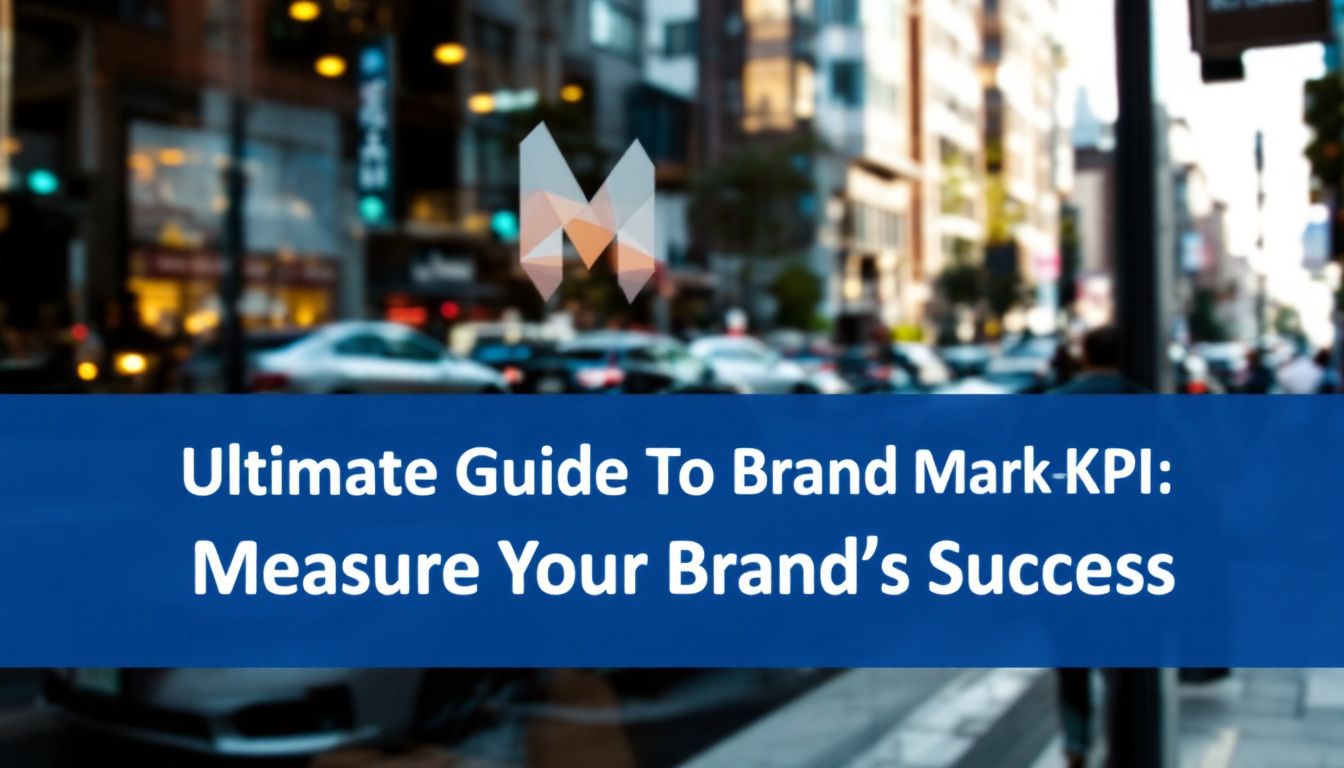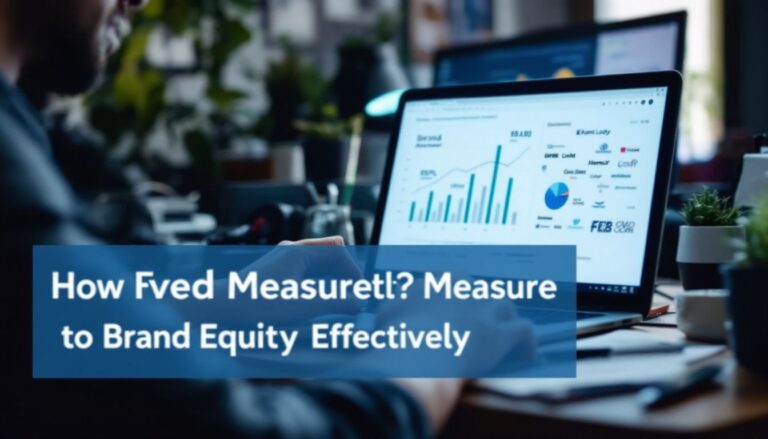Are you having trouble figuring out if your brand marketing is effective? It’s common to feel uncertain about how to measure success. But there’s good news—businesses that use clear Brand Marketing KPIs are twice as likely to reach their goals.
In this guide, I’ll share simple steps and easy-to-use metrics to help you check your brand’s progress. Keep reading, and you’ll soon turn guesswork into results you can count on!
Key Takeaways
- Brands with clear KPIs double their chances of hitting goals—but just 23% of marketers feel sure they’re measuring the right things.
- Useful brand KPIs to watch: brand awareness, engagement, customer sentiment, Net Promoter Score, customer lifetime value, and share of voice.
- Keep an eye on metrics across all your platforms—social media, websites, emails—to see clearly how your brand is doing.
- Tools like Google Analytics, Sprout Social, and HubSpot can gather your data and create simple, visual charts for easy insights.
- Start small, tracking just a handful of key metrics that match your top goals—one brand boosted click-through rates by 23% after changing their social content based on engagement numbers.
What Are Brand Marketing KPIs?

Brand marketing KPIs are numbers that show how your brand performs. I use these metrics to check if my marketing plans actually work. They measure things like how many people recognize my brand name, or what they feel about my products.
KPIs fit into different parts of the customer journey—from first hearing about the brand, all the way to becoming loyal followers.
In the awareness stage, key KPIs include sentiment scores, social mentions, and share of voice. Later, during purchase decisions, I track conversion rates closely to see if campaigns are truly working.
A brand management platform makes life a lot easier—gathering all the data neatly in one spot, helping me make smarter choices. Picking the right KPIs clearly shows me the best areas to focus my marketing budget.
Keeping track of these numbers matters—a lot.
Importance of Measuring Brand Marketing KPIs
So, we’ve covered what brand KPIs are—now let’s chat about why they matter so much. I track brand metrics for every client I work with; they clearly show whether marketing efforts hit the mark or miss it.
Without solid numbers, you’re just guessing how your brand is doing. Tracking KPIs across the customer journey shows exactly how you’re doing—from awareness cues like social mentions, to signs of customer interest like purchase intent.
Companies I’ve worked with that track sentiment and share of voice can catch and fix issues quickly. Data beats gut feeling every single time for smart marketing spend.
Good marketing comes down to proof—not promises. With the right KPIs, I pinpoint which channels deliver results and where I should trim budgets. For instance, checking your Net Promoter Score reveals how many customers would recommend your stuff, while Customer Lifetime Value spotlights which buyers bring the most business.
Tools like Google Analytics and social media reports now make gathering that data pretty simple. Brands that peek at these numbers every week—they adapt quickly, respond to market shifts early, and leave slower competitors behind.
Best of all, KPIs turn marketing effort into clear, simple language everyone on your team understands—even the folks who sign off on the budgets.
Key Brand Marketing KPIs You Should Track
Let’s look at the most vital brand metrics you need to track right now to see if your marketing works – I’ll show you which numbers matter most and how they can help your brand grow!
Brand Awareness
Brand awareness is right at the top of my marketing funnel—it’s a key sign that I’m doing something right. I mainly keep an eye on social mentions, top-of-mind recall, and share of voice.
Those numbers tell me how well people know my brand. For instance, I use social listening tools to track how many times users mention my brand online. This turns guesswork into clear, solid data.
Plus, the mood behind mentions matters—good feedback means our brand message is hitting home.
Measuring brand awareness helps me notice gaps in my marketing approach. My team takes these insights, then creates more focused campaigns to raise brand visibility. Share of voice gives me a quick idea about how we stack up against our market rivals—bigger percentages mean more people chat about us than the competition.
Insights from this data help me decide exactly where marketing dollars should go, boosting the chances of more visibility and growth.
Brand Engagement
Every day, I keep an eye on how people interact with my brand. Engagement tells me if people care about what I offer—through likes, shares, comments, or how long they spend checking out my website.
Social media posts do better when I post behind-the-scenes stuff or ask questions. Strong engagement means folks don’t just notice my brand—they actually feel connected to it.
I use tools like HubSpot to check clicks, shares, and comments across various platforms. Email open rates also let me know if my messaging resonates. One of the coolest things is that high engagement usually boosts sales and creates loyal customers.
I’ve noticed that posts telling short stories or giving quick tips get three times more interaction than basic product news. Engagement isn’t really about numbers—it’s about forming genuine relationships with people.
Brand Sentiment
Brand engagement shows how people interact with your brand—but brand sentiment captures how they actually feel about it. For me, sentiment is a key KPI in the awareness stage of marketing efforts.
It lets me quickly assess if a campaign really connects with my audience.
Positive sentiment usually means more social mentions and a stronger share of voice in the market. I use media monitoring tools to see if conversations about my brand lean positive, negative, or neutral.
That data shapes future campaign decisions, helping me spot potential loyal customers early on. The coolest part is… as sentiment trends upward, I can be confident my brand’s message resonates.
Net Promoter Score (NPS)
I use Net Promoter Score—or NPS—as a quick way to check brand health and customer loyalty. It’s based on a simple question: “How likely are you to recommend our brand to others?” The answer reveals if customers like your business enough to spread the word.
From my studies, only about 23% of marketers feel confident they’re tracking the right KPIs. But NPS clearly ranks as a critical measurement. It categorizes customers into promoters, passives, or detractors, giving scores that range from -100 to +100.
The higher your number—well, the stronger your brand’s fan base.
With NPS, I quickly spot issues at different stages in the marketing funnel—covering everything from awareness through the final decision step. It shows me where the brand strategy loses strength.
Because it’s so simple, NPS offers clear clues to future growth. Many major businesses rely on NPS to guide marketing decisions.
Keeping an eye on NPS, along with metrics like customer lifetime value, gives me a clear view of brand health. This means I know exactly where to focus marketing funds and make smarter choices overall.
Customer Lifetime Value (CLV)
After looking at how likely customers are to recommend your brand—let’s talk money. Specifically, the money customers bring to your business over time. Customer Lifetime Value (CLV) measures all cash spent by a customer, from their first buy through their very last.
It’s one key way I keep track of brand progress in the “Delight” stage of marketing. Yet, just 23% of marketers feel confident they’re measuring the right brand KPIs, and that includes CLV.
CLV gets even better if you link it with Customer Acquisition Cost (CAC) and ROI. Together, these numbers show clearly if your marketing dollars are paying off. From what I’ve seen, brands that track CLV closely make smarter marketing decisions.
CLV also helps convince management that brand-building efforts today pay off with higher sales tomorrow. Solid CLV results make it easier to justify future marketing funds—and grow your brand even more.
Share of Voice
I keep an eye on share of voice—that’s how much folks mention my brand versus competitors. It’s a quick snapshot of my brand’s visibility and how customers see my products. So, a higher number means more buzz around what I’m offering.
With this info, I can easily catch what’s missing in my marketing, and shape stronger campaigns. Social listening tools make the process easy, pulling data from various platforms. These figures show clearly whether my message stands out—or if it’s just blending in with everyone else’s.
Social Media and Website Metrics
Social media metrics clue me in to my brand’s online health. Likes, shares, comments, follower growth—they all tell me how folks feel about my content. These numbers clearly show what’s catching attention—and what’s falling flat—so I can shape future posts.
Website stats also matter. Bounce rates, page views, and how long visitors stick around tell me if they’re finding real value on my site. Google Analytics reveals exactly which pages hold interest—and which drive people away.
Together, social media and website data give me a clear snapshot of how my brand performs online.
How to Effectively Measure Brand KPIs
I need to track my brand KPIs with the right tools to get clear results. Good data helps me make smart choices about where to spend my marketing dollars.
Leveraging Analytics Tools
Every day, I use data tools to see how well my brand campaigns perform. Google Analytics, Sprout Social, and HubSpot let me easily track visitors on my website and social media. They give me clear numbers—who’s viewing my brand, clicking links, and buying products.
My team reviews the data carefully, to decide wisely on where marketing dollars should go. Plus, these analytics apps don’t stop at data collection alone—they quickly turn numbers into charts and visuals anyone can grasp.
Having the right tools helps me clearly show ROI to my boss. For instance, my dashboard points out exactly which social posts send the most visitors to our site. This way, I know if my brand message clicks or if it’s time to adjust.
And the great thing is—many useful tools are actually free or budget-friendly for small businesses.
Now, let’s check out tracking brand KPIs across different channels…
Tracking Across Multiple Channels
I keep a close eye on my brand—across social media, websites, emails, even offline ads. This helps me know exactly where customers find me. Marketing tools make this simple. Google Analytics shows me clearly where web traffic is coming from.
Social platforms provide their own dashboards, filled with useful numbers and trends. Connecting all these insights gives me the full, complete picture.
Real insight happens when trends emerge across channels. For instance—I found Instagram brought lots more web visitors than Facebook did. But Facebook users ended up buying more often.
Knowing this, I fine-tuned my content differently for each platform.
Now, here’s how these KPIs can boost your own brand strategy.
Using Brand KPIs to Optimize Strategies
I use KPI data to craft clear action plans—and that helps my brand succeed. My marketing team tracks performance metrics to figure out what’s working, or what needs fixing. Brands using KPIs instead of guessing usually perform better.
Last year, after adjusting social posts based on engagement numbers, my click-through rates went up by 23%. Brand awareness scores tell me if my messaging hits the right audience. Customer lifetime value helps spot which buyers add the most profit over time.
Net Promoter Score highlights loyal customers who openly recommend my products—so I can build programs that keep them happy. Social media metrics reveal which content gets comments and shares.
Website analytics show how visitors behave on my pages. These insights guide exactly where I spend my marketing budget for the highest return. Good tools—like Google Analytics or social listening software—make tracking simple.
Watching key metrics closely helps me spend smarter and get stronger results.
Conclusion
Brand KPIs change vague guesses into clear facts about marketing impact. My tip? Start simple—pick just a few measures that line up with your goals, then add more as you go. Good data helps you spend money and time wisely.
Numbers show the real deal about your brand—they tell you what’s clicking and what’s falling short. Check your metrics often, tweak your plans as needed, and watch your brand grow stronger with each smart step you take.





